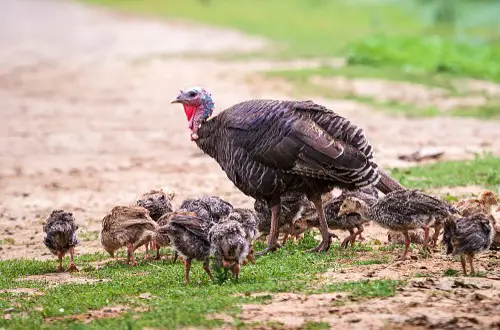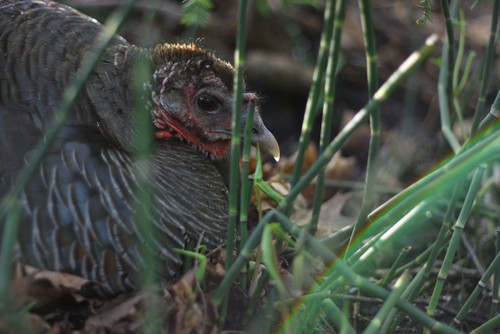Turkey nests are the wild turkeys only guarantee of future generations. With their short life-spans (2-4 years), turkey hens must be highly reproductive, select secure nesting locations, and survive long enough to see their poults reach their fourth month.
For turkeys, the only way to win the war against the law of averages is to have as many successful nests as possible. And the wild turkey is built for battle.

Turkey nests: A hen’s first duty.
In the wild, the most productive turkey hens are over one year old and weigh at least 9.5 pounds. The heavier a hen weighs the more likely she is to survive the previous winter, breed, nest, and produce a high number of poults.
After a successful turkey breeding season, a hen will select an area that provides good cover from visibility and is close to an excellent brooding environment. Here she will build her ground nest and start laying eggs.
A turkey hen lays one egg about every 28 hours. During the next two weeks, her activities will consist of laying eggs, foraging for food, and preparing her body for the four-week incubation and protection of her brood.
Related: What is the best time of day to turkey hunt?
Where do turkey lay their eggs?
A turkey hen will build her nest in an area that provides concealment from predators and an elevated place to watch over her brood. Typical nesting sites include the base of trees, hay fields, and low spots inside dense patches of vegetation.
The most critical factor concerning the selection of turkey nesting sites is the habitation’s ability to protect against predators.
Turkeys will only use the dead leaves, grasses and other plant materials near the nesting site to build the nest.
If the nest is lost, some turkey hens will attempt as many as three times to build a replacement.
Related: How to find a wounded turkey.
Related: Is it a jake or a tom?

What causes turkey nests to fail?
There are four most common reasons a turkey nest fails:
- Abandoned by the hen.
- Death of the hen.
- Discovery by predators.
- Destruction by humans.
Why do turkey hens abandon their nests?
Turkey hens are naturally nervous and easily frightened. The less time a hen has spent incubating her eggs, the more likely she is scared off the nest for good. If the nest no longer appears safe, it will be abandoned and another built.
What destroys turkey nests?
Predators, like coyotes and foxes, and egg eaters such as skunks, ravens, raccoons, and crows are responsible for over 50% off all turkey nest destruction. 20% of nests are destroyed accidentally by farming and ranching activities, and hen death and nest abandonment cause 20% of all nest failures.
During the 28 day incubation period, only four in ten turkey nests will be successful.
What helps turkey populations grow?
Older, heavier hens are twice as likely to produce poults because of a greater likelihood of surviving the incubation process, producing more significant numbers of eggs, and replacing destroyed or abandoned nests than lighter, younger hens.
As one of North America’s favorite games species, much depends on the continued survival of the wold turkey. Turkey nests are key to this survival.

